Microsoft Surface Pro 3: Hands On, Display & Performance Preview
by Anand Lal Shimpi on May 20, 2014 3:25 PM EST- Posted in
- Tablets
- Microsoft
- Mobile
- Surface
- Surface Pro 3

Earlier today Microsoft announced its 3rd generation Surface Pro device, aptly named the Surface Pro 3. This is the first Surface model to deviate from the 10.6" 16:9 form factor of all four previous devices (Surface Pro, Surface RT, Surface Pro 2, Surface 2) and instead standardizes on a 12" 3:2 form factor. The resulting device is also substantially thinner, now at 9.1mm (0.36"). Surface Pro 3 is now somewhere between the thickness of Surface 2 and Surface RT.
The original Surface Pro featured a kickstand that could stay open at a fixed 22-degree angle. Surface Pro 2 added another stop (40 degrees) to the kickstand to allow for more flexible, laptop-like operation. Surface Pro 3 features the same initial 22-degree stop, however it can be opened to any angle beyond that (up to 150-degrees) using a new high friction hinge. The hinge opens with little effort to its first stop, anything beyond that requires additional force. It's enough to feel secure, but not too little that the hinge loses its position. It's unclear how this new hinge will hold up over time but I suspect Microsoft put a good amount of testing into it.
With the device width comes a new type cover with a larger trackpad and secondary magnetic strip. The second magnetic strip can provide a second attach point to the Surface Pro 3, allowing the cover to be a more stable base when used in laptop mode. In practice the new hinge with more stable type cover creates a much more laptop-like base, which definitely comes in handy when typing on your lap. In my brief time with the review unit I still found it to be less stable than a laptop, but it's a far closer approximation to the laptop experience than it ever has been before.
The new trackpad is substantially larger horizontally and features a new lower friction surface. The trackpad is actually a clickpad with left/right buttons activated by pushing down on the lower left/right corners of the clickpad itself. Using the integrated trackpad on previous Surface covers was an exercise in madness that got mildly better last generation.
Right off the bat the new clickpad on the 3rd generation type cover is a lot better, but it's still not in laptop-territory as far as experience goes. I'll need to spend more time with it to see if it's truly past the point of being frustrating to use.
There's a new battery powered pen for Surface Pro 3. You lose some pressure sensitivity (256 levels vs 1024), but there are new features that Microsoft hopes will make up for it. I haven't spent much time with the new pen at all so I'll save commentary on it for the full review.
The new design features the same sized battery as previous Surface models. I'm guessing we'll see a reduction in battery life given the new, presumably higher power display, but I'll find out for sure over the coming days.
Microsoft also added 802.11ac support to the new Surface Pro courtesy of Marvell's Avastar-AC solution (88W8897 perhaps?).
And yes, connected standby is supported.
| Microsoft Surface Pro Comparison | |||||||||
| Surface Pro 3 | Surface Pro 2 | Surface Pro | |||||||
| Dimensions | 11.5 x 7.93 x 0.36" | 10.81 x 6.81 x 0.53" | 10.81 x 6.81 x 0.53" | ||||||
| Display | 12-inch 2160 x 1440 | 10.6-inch 1920 x 1080 w/ Improved Color Accuracy | 10.6-inch 1920 x 1080 PLS | ||||||
| Weight | 1.76 lbs | 2.0 lbs | 2.0 lbs | ||||||
| Processor | Core i5-4300U with HD4400 Graphics (15W Haswell ULT) | Core i5-4200U with HD4400 Graphics (15W Haswell ULT) | Core i5-3317U with HD4000 Graphics (17W Ivy Bridge) | ||||||
| Cameras | 5MP/5MP (front/rear) | 1.2MP/1.2MP (front/rear) | 1.2MP/1.2MP (front/rear) | ||||||
| Connectivity | 802.11ac WiFi | WiFi | WiFi | ||||||
| Memory | 4GB or 8GB LPDDR3 | 4GB or 8GB LPDDR3 | 4GB | ||||||
| Storage | 64, 128, 256 or 512GB |
64 or 128GB (4GB RAM) 256GB or 512GB (8GB RAM) |
64GB or 128GB | ||||||
| Battery | 42.0 Wh | 42.0 Wh | 42.0 Wh | ||||||
| Starting Price | $799 | $899 | $799 | ||||||
Display
With Surface Pro 3, Microsoft finally accepts that while 16:9 may be a great aspect ratio for watching movies but it's not optimal for a multi-purpose tablet. The tablet features a 12" 2160 x 1440 display (RGB stripe, not RGBW/PenTile), which ends up being a 3:2 aspect ratio. The difference is immediately noticeable in notebook-style use. While the Surface Pro 2 was never quite all that comfortable to use as a laptop, Surface Pro 3's display makes it substantially more laptop-like. There doesn't appear to be a substantial impact to tablet use either with the larger display. Particularly with Windows 8.1's split screen mode, the larger display ends up working extremely well. I'll talk about the new hinge a bit more in the usability section but the aspect ratio alone is a huge step forward.
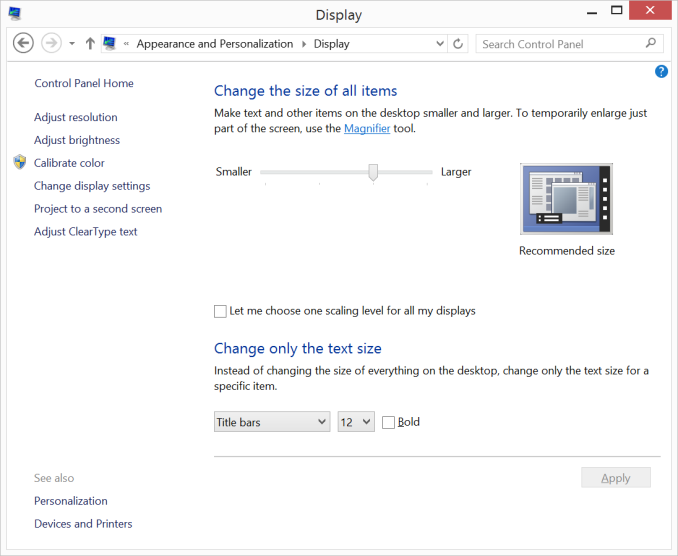
Default Scaling on Surface Pro 3
Color accuracy is improved out of the box as well. The original Surface Pro had a display capable of being quite accurate, if calibrated, but out of the box it was a bit of a mess. Microsoft slowly improved out of box calibration over the years, eventually culminating in what we have today with Surface Pro 3.

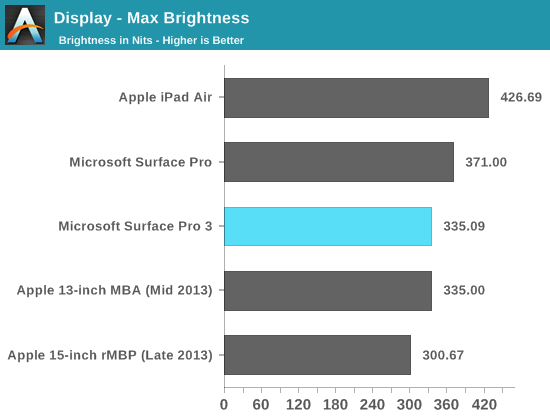
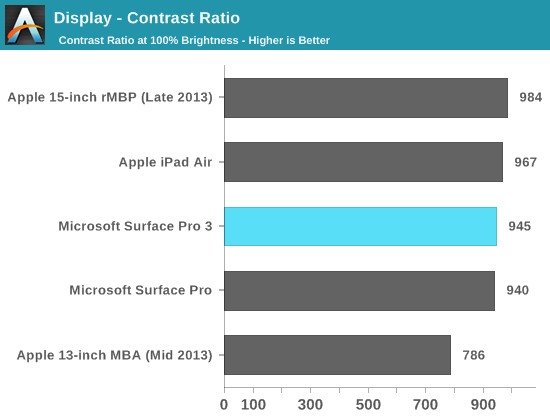
Max brightness drops a bit compared to Surface Pro 2, likely due to the Pro 3 having 50% more pixels to light. Black levels at max brightness are pretty good, thanks in part to Microsoft's optically bonded LCD/cover glass stack. Contrast ratio remains competitive with previous designs.
Grayscale accuracy is the biggest issue with the new display, green levels are just way too high:
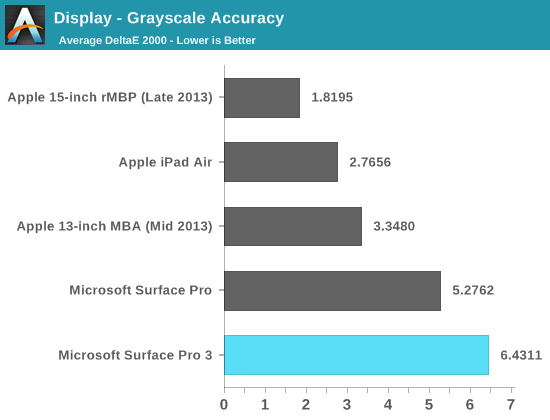
Our basic sRGB gamut test paints a great picture for Surface Pro 3. Full saturation color reproduction is excellent:
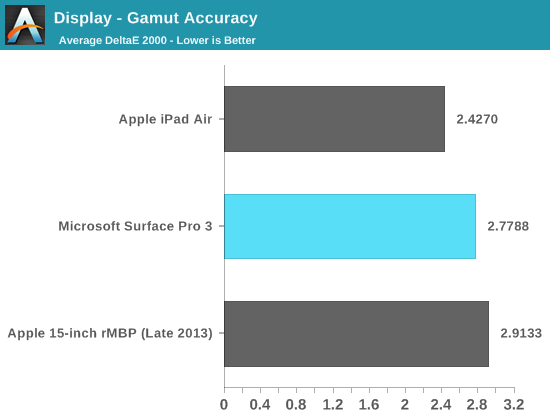
The saturation sweep also looks solid:
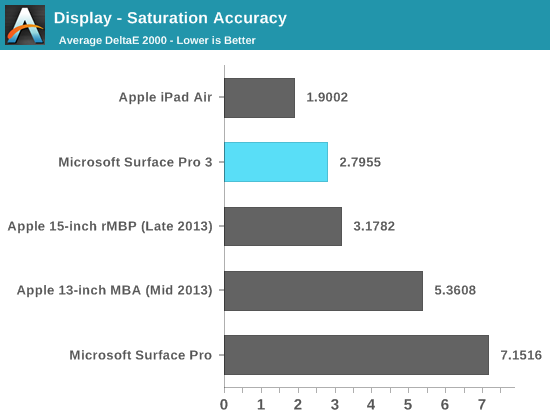
Unfortunately Surface Pro 3 doesn't do so well on our GMB color checker test. Part of the problem is its performance in the grayscale swatches included in this test:

Overall the display is a big improvement over the previous Surface Pro generations, but it's still behind iPad Air territory in terms of color reproduction which is disappointing. Given Microsoft's focus on Surface Pro 3 as an image editing tool, I would've hoped for class leading performance across the board.
Performance
Surface Pro 3 still uses a 15W Haswell ULT SoC. My review sample uses a Core i5-4300U (a speed bump of SP2's original 4200U), although there are also Core i3 and i7 options as well. In the case of the i5-4300U we're talking about a dual-core/4 thread Haswell part with a 3MB L3 cache. The CPU cores run at up to a 1.9GHz base frequency and 2.9GHz max turbo. The latter is quite impressive given the incredibly thin (9.1mm) Surface Pro 3 chassis. My guess is that Intel is giving Microsoft the best binned Haswell ULT parts to ensure good performance at low thermals. There are still 4GB or 8GB memory options, although my sample came with 8GB of LPDDR3.
I saw sustained speeds of 2.6GHz while running single-threaded Cinebench 11.5:
The system's internal fan was definitely audible during the Cinebench run.
On the storage front Microsoft is still using a SATA based drive. It's unfortunate that more PC makers haven't shifted to PCIe, although I suspect that'll come next year with NVMe based solutions (I hope). My review sample featured a 256GB Samsung PM851 drive, this is an OEM version of the TLC based Samsung SSD 840 EVO.
Despite featuring a thinner chassis, I measured performance improvements over both previous Surface Pros. I'll have more data in the final review but here I'm seeing a 3 - 20% increase in performance over the Surface Pro 2.
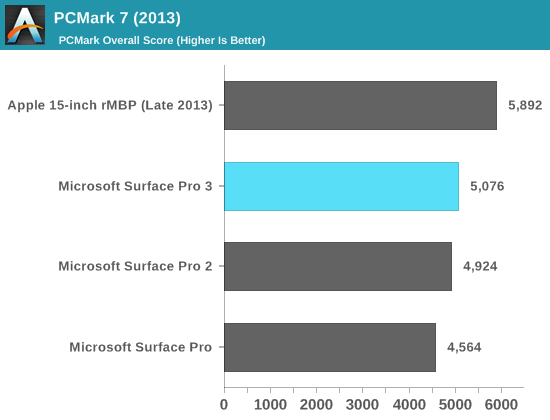

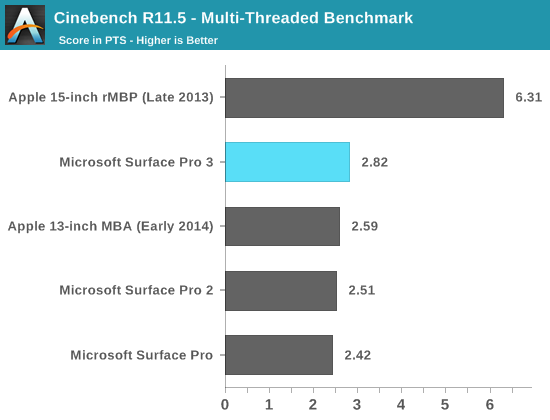
Final Words
There's a lot more work to do on Surface Pro 3, including substantial battery life testing and continued usage. If there's anything in particular you guys want to see us touch on, leave it in the comments below.


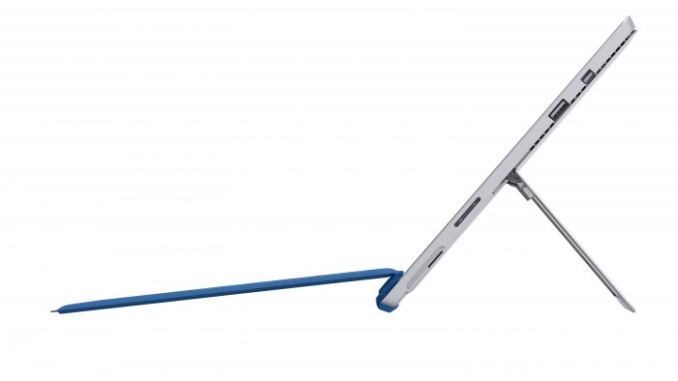
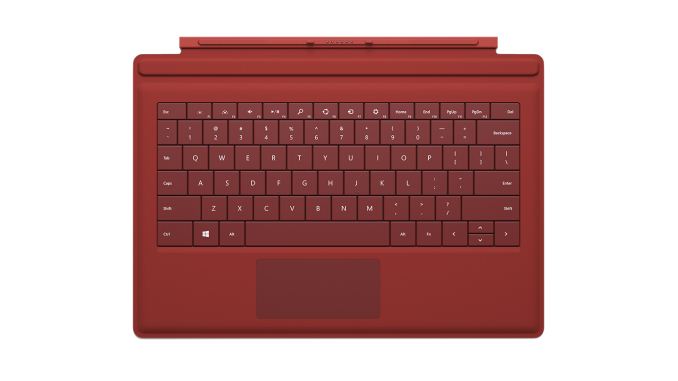
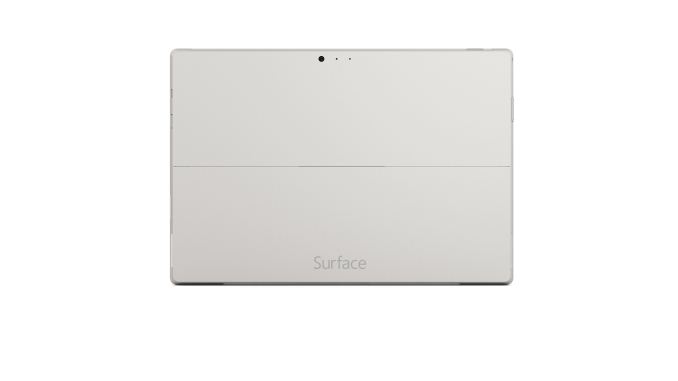
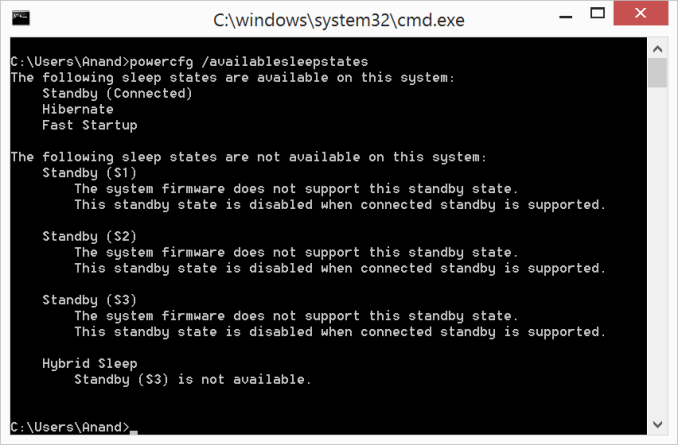
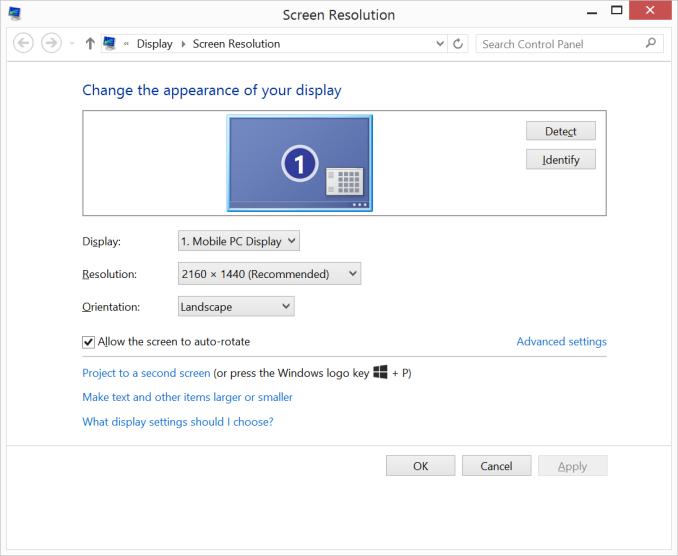



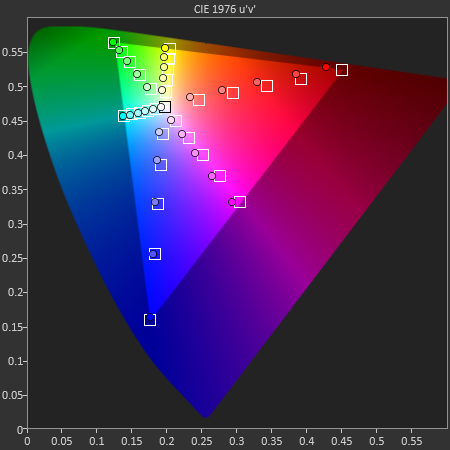


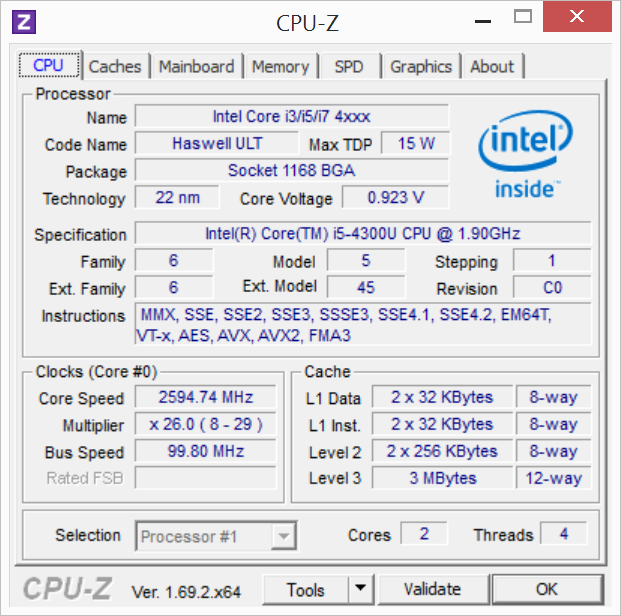
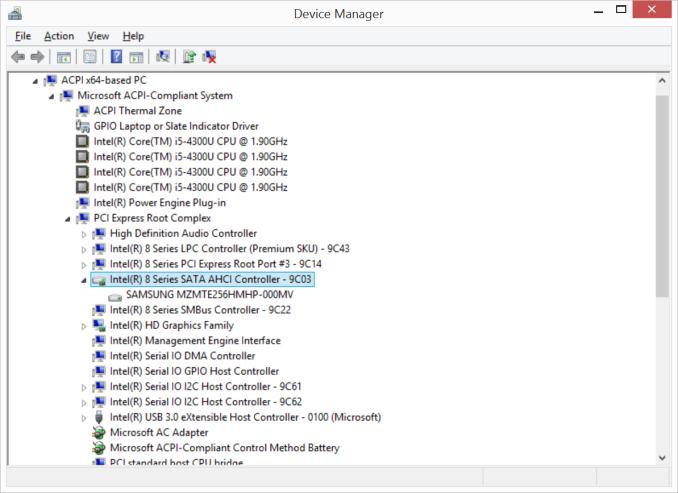








295 Comments
View All Comments
rituraj - Tuesday, May 20, 2014 - link
I'd also bet an i5 will destroy an A7 any time of the day except for some itunes blah blah test.akdj - Saturday, May 24, 2014 - link
Was that supposed to be a serious comment? A 15watt core i3/5/7 CPU and iGPU with 4/8GB RAM compared to a single watt SoC with a GB of RAM? Hmmm...not quite sure you're understanding the 'subtle' differences between devices. In fact, the answer to 'your bet' is right THERE! In the 'actual' pre-review! Maybe that was an attempt at an iOS or Apple 'dig' but...if you're truly serious about an apples to apples comparison {pun intended}. Please look at a MacBook Air's core i5 build vs. The SP3. Lots to be said for the SP3 in comparison to the MBA but they recently dropped the Haswell Airs that include the HD5000 iGPU as well as PCIe SS storage. Significantly quicker. Though the SP3 has the Air beat hands down in the display resolution department, it would make me a bit nervous, as the first generation rMBP 13" Intel core i5/4000 models with 8GB of RAM were at times a bit 'glitchy' while scrolling busy pages, graphic intensive applications, etc. Lotsa pixels means plenty of graphic power overheard to keep that consistent 60fps UI fluency we've all grown accustomed to in the lower rez displays. That said, the 13" rMBP this year configured identically to the SP3 is in parity with price, though a bit cheaper considering you'll have to add the keyboard to the SP rig. HiDPI displays from both sizes, I believe the 15" rMBP is $1999 with the core i5/8GB RAM/Intel 5200, the high end Iris Pro and even higher resolution. So at that high end pricing bracket, the choices are plenty but...that's comparing apples to apples. Not the Surface RT, Galaxy Note X.x or the iPad to a core i5 laptop. Doesn't work like that. Nor are they for similar use cases.Honestly, I enjoy both Windows and OSx...as well, iOS and Android. If you're not so religious, you'll open your mind and find there are some incredible 'up sides' to different OS'es, UIs, software, doc, motion, and still shot editors...you name it. Lotsa choices, excellent completion equals a PERFECT outcome to all of us...the customers;)
HeroicNate - Tuesday, May 20, 2014 - link
My big question, is this the same LCD used in laptops like the Lenovo Thinkpad yoga? The thinkpad version of the yoga had a 12.5"(I realize it's a .5" diff) screen that had really bad image retention issues. That would be a huge strike for me if the pro 3 has the same issue. I just got my surface pro 2 a few weeks ago and now I'm debating whether I should return it and get the pro 3 instead. I love the pro 2, but if I can get the pro3 at the same price it seems like i should.HeroicNate - Tuesday, May 20, 2014 - link
After reading through the comments I ended up checking my pro 2. I actually have the 4300 cpu so that actually makes me lean more towards keeping what I have. If the biggest difference is the screen size and kickstand now, I can't tell if it'd really be worth returning and waiting for the pro 3. The fact that the pro 3's resolution is higher makes me thing I'll probably end up getting better performance with my pro 2 of a lower res. If the n-tech pen works as well as wacom I see that as a 0 diff. They both have pitfall's from what I read.westphillyres - Tuesday, May 20, 2014 - link
So THIS is the website where I belong. Exactly the kind of hands on I was looking for. I was saying to myself, "If they GAVE the tablet to these journalists, why are they only doing a 3 minute hands on with info we already know?"nomaddave - Tuesday, May 20, 2014 - link
As others have said, iGPU/video suite benchmarks would be extremely helpful to gauge use case scenarios with video editing packages. Seems to be one direction Microsoft is trying to heavily market these devices toward as well.mmaestro - Tuesday, May 20, 2014 - link
Any way to tell if that SSD is utilizing eDrive? If it's an offshoot of the EVO, it ought to be able to support it, right?TechieSandy - Tuesday, May 20, 2014 - link
Can someone do professional video editing on the top end model? Also, dos the Top end model have a quad core or dual core i7. Does it have a dedicated graphics card?HeroicNate - Tuesday, May 20, 2014 - link
I can almost guarantee it does not have a dedicated video card. there is no space and it's all listed as intel graphics.rituraj - Tuesday, May 20, 2014 - link
scratch the 'almost' part. The i7 will be dual core 4 thread. the quad core ones will require it to be an inch thick.@Techiesandy, depends on what level of performance you are expecting. Never gonna replace your desktop. But still quite capable. Can output to a 4K resolution display (not sure if 30Hz or 60) so figure it yourself.